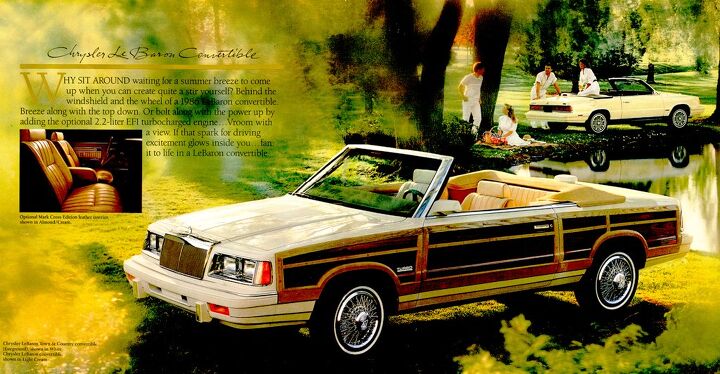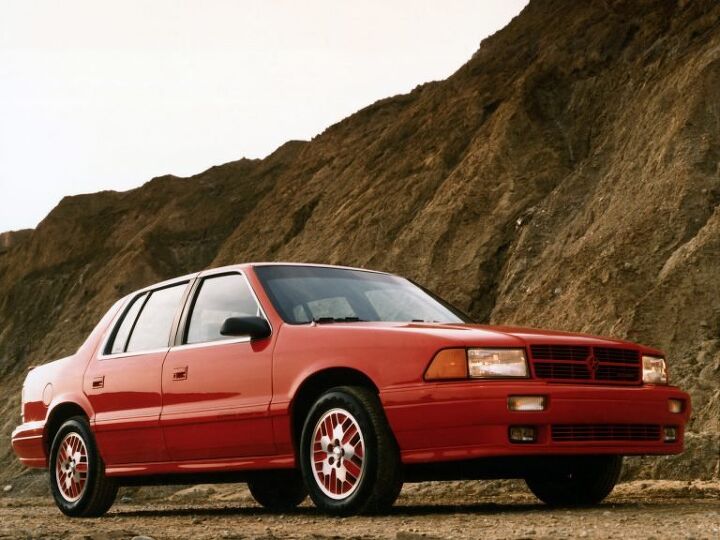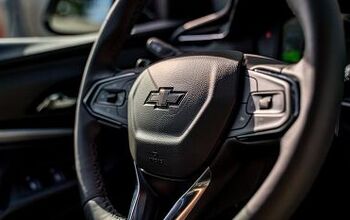Here Are All the Ways Chrysler Tried To Turbocharge the 1980s
It was impossible to escape the word “Turbo” in the 1980s.
There were Turbo Aviators and Turbo Hoover vacuums. Turbo was a character on American Gladiators. There was even Turbo chewing gum, which came with a cool mini car poster wrapper. Turbo was a helluva drug in the 1980s, and Chrysler took note.
BMW offered one turbocharged gasoline model. Porsche offered three. But Chrysler? Over a 10 year span, the Pentastar turbocharged its entire car lineup, bringing us some 20 turbocharged models powered by no less than six different variations of the 2.2- and 2.5-liter inline-fours.
What was perhaps most interesting about the Chrysler turbocharged four was that it was never intended to be a performance engine. Instead, Chrysler developed it in the 1970s as a reaction to the oil crises.
Then the ’80s happened.
When turbo became all the rage, Chrysler turned to its engineers and told them to develop a turbocharged engine. It may have been a bit crude compared to European efforts, but Chrysler’s collaboration with Garrett Research resulted in some serious firepower. The greatest development of the 2.2-liter engine produced 224 horsepower in 1991.
Never really known for its refined, well, anything, Chrysler now had some serious speed potential and it sprinkled it on basically every model it could. Here are some of the results.
Dodge Omni
Though they bore a fair amount of resemblance to other Chrysler products, the Dodge Omni and Plymouth Horizon twins weren’t based on the popular K platform, but the French Simca-based L platform. These models carried the first variation of the 2.2-liter SOHC Turbo (I), which was nominally rated at 142 horsepower. That may sound relatively modest, but adding the Garrett Research T3 turbocharger to the inline-four produced more power than Chrysler’s 3.0-liter V6 and 318 ci V8 at the time.
Power was later upgraded in 1987 with the GLH-S, which used the Turbo II engine. Sprouting an intercooler increased horsepower to 174 — about a 50 horsepower advantage over a contemporary GTI 16V. It had cool wheels, cooler graphics and the coolest name: Goes Like Hell.
Which would you rather drive? That’s right, the GTI.
Chrysler E-Class/New Yorker, Dodge 600, Plymouth Caravelle
The new E-Class platform for 1983 was a lengthened version of the K platform for added luxury. As with the original Omni GLH model, power came from the 142-horsepower Turbo I. The 600’s styling may be forgettable, but Chrysler claimed the drop-top scooted from 0-60 in under 6 seconds. You needed that speed to avoid nauseous bystanders viewing the styling. Production wrapped up on the E-Class with the equally unremarkable late-80s New Yorker Turbo.
Chrysler LeBaron/Town & Country
Wait, this is a different convertible than the one above? The K platform was a pretty popular one for Chrysler, sprouting an astonishing 42 derivatives over its lifespan. As with earlier models, both the LeBaron and LeBaron Town & Country (with its faux wood exterior) got their power from the Turbo I engine, which was probably the only cool thing about them. Of course, if the faux-wood droptop Town & Country was good enough for “ John Voight,” maybe it’s good enough for you, too?
Chrysler LeBaron GTS, Dodge Lancer, Shelby Lancer
The LeBaron and the LeBaron GTS shared exactly three things: a name, the basic K-platform, and a motor. Outside of that, the GTS was more modern, aerodynamic, and a bit more swift.
Utilizing the Turbo I, Chrysler claimed in advertising the GTS outperformed the BMW 528e and Mercedes-Benz 190E. Its sibling, the 1987 Shelby Lancer, was the hot item here, with the intercooled Turbo II offering 175 horsepower “tuned” by the Cobra legend and limited to only one color and 800 examples.
Strangely, the Shelby Lancer then later became the Lancer Shelby in ’88/’89. Though more rare than the ’87, they weren’t officially produced by Shelby Automobiles.
Of course, the market is ablaze with people seeking out clean examples of these cars and not the E28 or W201, right?
Chrysler Lebaron GTC/TC by Maserati
Chrysler further refined altered the LeBaron with the “new” J platform, a revised version of the K platform, and added all-new convertible and coupe models. Production of the new LeBaron started in 1987, so all turbocharged models had the Turbo II (174 hp, intercooled) engine. The topless model even became the official 1987 Indianapolis Pace Car if you can believe it.
While the Maserati moniker added some arguably undeserved name recognition in the TC model for the European crowd, performance was pretty stout in manual models, which carried a 16 valve DOHC Cosworth-developed version of the 2.2-liter engine rated at 200 horsepower.
In 1989, Chrysler downgraded the TC’s power with the 2.5 SOHC Turbo rated at only 150 horsepower; however, the company also offered a revised GTC Turbo in 1990, which brought power back up to 174 with the Turbo IV through the use of “Variable Nozzle Turbine” technology. You would instantly lose friends if you tried to explain Variable Nozzle Turbines at a party — but it was quite technically impressive in its day.
*crickets*
Dodge Daytona, Shelby Charger
As with the LeBaron, the Daytona was a well-established name that the company then used in a dizzying number of variations. Unlike the LeBaron, these coupe variants were based on the Omni’s L platform. There was the normal Daytona, Daytona Turbo, Daytona Turbo Z, Daytona Pacifica, Shelby Z Daytona, and Shelby Charger — all of which used the Turbo I.
In 1989, Dodge moved the Daytona models to the 2.5-liter Turbo I, which was downgraded to 150 horsepower in the Daytona Turbo ES. That might have seemed disappointing, but Chrysler fixed this in 1990 with the Variable Nozzle Turbo IV in the Daytona and Daytona Shelby models.
Still, it was the last run Daytonas that got the big power. Utilizing the ultimate development of the TC motor, Dodge offered the new DOHC 16 valve Turbo III rated at 224 horsepower in the 1991-1993 Daytona IROC R/T. That was impressive power for what was effectively a chassis one generation separated from a horse-drawn wagon. Despite the name IROC, the model shared nothing in common with the real racing IROC Daytonas other than a general resemblance.
Dodge Spirit, Plymouth Acclaim
To replace its aging, front-drive sedans, Chrysler once again turned to a modified version of the K platform. (Surprise!) The new AA platform saw another variant of the LeBaron launched (yes, really), but turbocharging was left to its sibling Spirit and Acclaim models as Chrysler wanted to market the LeBaron as more “upscale” (read: more velour, Landau tops and faux-wire wheels). Both started life with the 2.5-liter SOHC Turbo I with 150 horsepower through 1992, but the Spirit was given an extra boost with the R/T model in 1991. It shared the Turbo III 224 horsepower motor seen in the Daytona IROC R/T, but in a package slightly more modern than the L chassis.
Plymouth Sundance, Dodge Shadow, Shelby CSX
To replace the very tired L platform in the late 1980s, Chrysler turned to — you guessed it — the K platform.
Modifying it into the new P platform gave the company a few small hatchback-coupe models. As with other models, starting in 1987, the base 142 hp Turbo I powered the Sundance and Shadow models. Chrysler then turned to Shelby again to produce the Shadow-based CSX variant, which used the 174 hp Turbo II.
In 1990, the CSX moved to the Variable Nozzle Turbo IV and could apparently hit 156 mph flat-out. No, I’m not kidding. If you’re counting, Shelby made this technology work an astonishing 17 years before Porsche and the CSX was also the first production car to wear composite wheels.
Dodge Caravan, Plymouth Voyager
Okay, this is getting a bit out of hand, right?
Well, the company that brought us the minivan at least had the gumption to turbocharge it, too. Since the minivan S platform was, no surprise, based on the K platform, all of Chrysler’s turbo running gear fit right in.
Starting in 1989 and for a three-year period, you could opt to get the 2.5-liter SOHC Turbo I in your Caravan or Voyager. These minivans could even be mated to a five-speed manual transmission, meaning that you had a people hauler capable of just plain hauling. There’s still a fringe community who loves ( and drag races) these vans.
More by Carter Johnson
Latest Car Reviews
Read moreLatest Product Reviews
Read moreRecent Comments
- Lorenzo This car would have sold better if there was a kit to put fiberglass toast slices on the roof.
- Lorenzo The Malibu is close to what the 1955 Bel Air was, but 6 inches shorter in height, and 3 inches shorter in wheelbase, the former making it much more difficult to get into or out of. Grandma has to sit in front (groan) and she'll still have trouble getting in and out.The '55s had long options lists, but didn't include a 91 cubic inch four with a turbo, or a continuously variable transmission. Metal and decent fabric were replaced by cheap plastic too. The 1955 price was $1765 base, or $20,600 adjusted for inflation, but could be optioned up to $3,000 +/-, or $36,000, so in the same ballpark.The fuel economy, handling, and reliability are improved, but that's about it. Other than the fact that it means one fewer sedan available, there's no reason to be sorry it's being discontinued. Put the 1955 body on it and it'll sell like hotcakes, though.
- Calrson Fan We are already seeing multiple manufacturers steering away from EVs to Hybrids & PHEVs. Suspect the market will follow. Battery tech isn't anywhere close to where it needs to be for EV's to replace ICE's. Neither is the electrical grid or charging infrastructure. PHEV's still have the drawback that if you can't charge at home your not a potential customer. I've heard stories of people with Volts that never charge them but that's a unique kind of stupidity. If you can't or don't want to charge your PHEV then just get a hybrid.
- AZFelix The last time I missed the Malibu was when one swerved into my lane and I had to brake hard to avoid a collision. 1 out of 5⭐️. Do not recommend.
- 2ACL I won't miss it; it was decent at launch, but in addition to the bad packaging, GM did little to keep it relevant in the segment. I'd prefer that another domestic automaker doesn't just give up on the mainstream sedan, but unlike some of Ford's swan songs, the Malibu made an indifferent case for why they should live.











































Comments
Join the conversation
1980's Chrysler turbos were a definite step up after cars hit bottom in 70's. I had Omni GLH and it was a good car----for the time. 140hp doesn't sound like much, but Omni weighed 2500 pounds. 140hp isn't bad compared to 165hp Corvette.
My father in law has a Dodge 600 convertible with the 2.2 turbo, which just got pulled out of the garage and onto the road this summer (after 12 years laying dormant)...interesting to drive to say the least. I never, ever, get tired of hearing that turbo spool up and kick in at about 60% throttle.